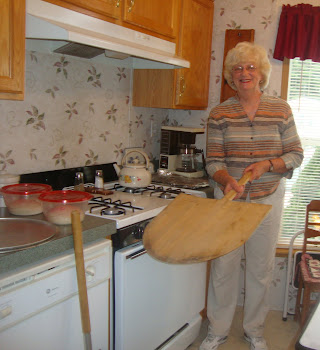The Sloan clone dough ball developed a
bubble on the top at one place while it was in the deli case. When
the dough ball was taken out of the deli case I did pinch the bubble
to deflate it. The dough ball sat out to warm up for about 1 ½ hrs
and no more bubbles formed on the top. There were no fermentation
bubbles while pressing it out. The Sloan clone dough balled pressed
out okay. The dough ball didn't have great elasticity or
extensibility though. The temperature at market yesterday was about
94 degrees F or a little hotter right next to the oven and was very
humid. Since it was very humid, like it is sometimes in hot weather
at market, flour wants to stick to the work bench and on my hands
more than usual. I knew I would not be able to open the dough ball
more over the marble table with trying to slide it around a lot
because of the sticking flour and because the dough is so thin. I
did the best I could though and finished stretching by hand to a
finished skin size of 14” The Sloan clone dough pizza was dressed
with Sorrento part skim mozzarella that I grated and a blend of Red
Pack tomatoes crushed and 6-in 1s. Olive oil was drizzled over the
top of the dressings before it went into the oven.
Steve and I tasted a piece the Sorrento
part skim mozzarella and we thought it had a good taste. The
Sorrento part skim mozzarella really wanted to get soft quick at
those higher temperatures and we did leave the Sorrento part skim
mozzarella that I grated in the pizza prep fridge until I started to
open the dough ball.
The Sloan clone dough pizza baked well
at my oven temperatures and the rim was oiled near the end of the
bake. After the bake more olive oil was drizzled on top of the
pizza. As I posted in my last post the pizza was crisp and crunchy
across the whole pizza after the bake. The bottom of the crust did
brown well too without any sugar. Steve and I wondered how such a
thin pizza with not many dressings takes so long to bake.
The photos show more how the bottom
crust looked, but the rim crust was really darker than it appears on
some of my photos. The semolina side of the dough was used as the
bottom crust and we didn't taste any semolina or see it on the baked
bottom of the pizza. The semolina did stick to the bottom of the
dough ball. The rest of the semolina on the bottom of the plastic
container did not stick to the plastic container even though there
was some condensation on the lid of the plastic container. The
remaining semolina in the plastic container could have been easily
dumped out.
As I posted before the Sloan clone
dough made a pizza that reminded me of of the pizza Trenton Bill and
I ate at De Lorenzo/Robbinsville. I think a little more salt could
have been added though and am not sure if the Sloan clone dough
formulation mixing was enough.
Norma




























No comments:
Post a Comment